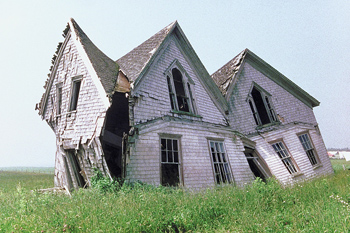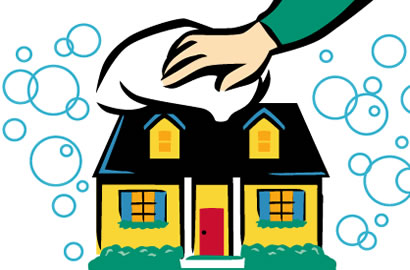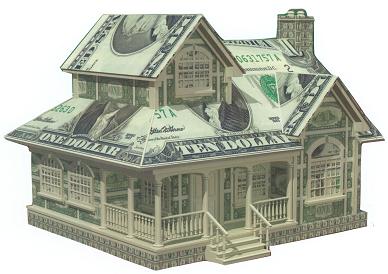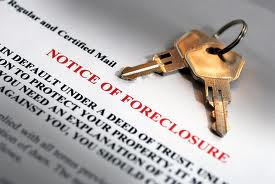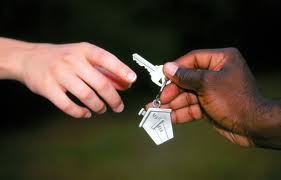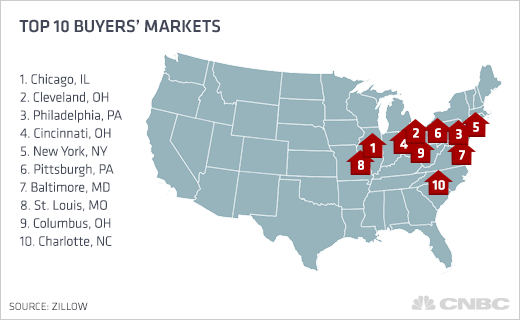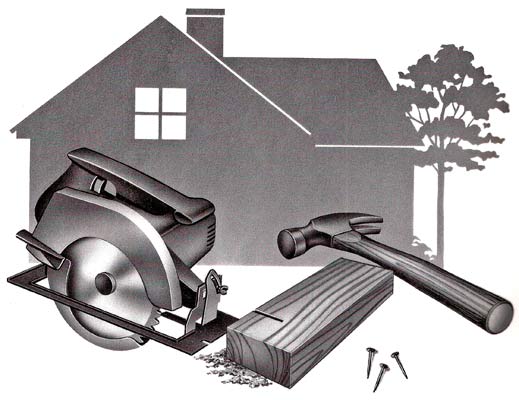
BLOG
8 Dirty Secrets in Your Home
Steel yourself: We help you expose — and purge — your home’s dirtiest little secrets.
Deep breath ...
1. Cruddy undersides of rugs 2. Disgusting disposal 3. Greasy kitchen vent hood 4. Crumby kitchen crevices 5. Grimy fans and ceilings 6. Grungy toilets 7. Debris-filled crawlspace 8. Linty dryer vents
1. Cruddy undersides of rugs
Look under your area rugs for a nasty surprise -- a sea of grit and dust -- despite regular vacuuming. What to do:
- Move furniture, fold over the rug, and vacuum dirt and dust from its underside. Sweep and mop the floor, too.
- While you’re under the hood, check the rug’s condition. If there’s no staining or discoloration, a good floor cleaning and vacuuming of the rug’s underside is enough.
- If pets, kids, or wine have left their mark, invest in a professional cleaning. A pro will run between $1.50 and $3 per square foot of rug, depending on the type of rug. Delicate natural fibers are usually more costly to clean than synthetics.
2. Disgusting disposal
Your kitchen has more germs than even your bathroom. And your garbage disposal and its splash guard flaps just might be the most disgusting place in the house — slimy, smelly, and befouled with old food. What to do:
- Scrub the underside of the rubber flaps with an old toothbrush and warm, soapy water.
- Pour a 1:1 ratio of white distilled white vinegar and baking soda down the drain. Let it sit overnight and flush with boiling water to sanitize.
- Toss frozen cubes of white vinegar (just freeze it in an ice tray) down the disposal while it’s running. This will sharpen and sanitize the disposal’s grinding blades.
- Freshen up the drain with slices of lemon or other citrus fruit. Peels are OK, but if you have fruit to spare, the citrus acids will help disinfect and freshen.
3. Greasy kitchen vent hood
Your range vent hood works hard to absorb smoke, steam, and grease. Just like you change air filters to extend the life of your HVAC, you should clean the vent filter. Not only will this make the vent more efficient, it’s a safety measure. Should you have a grease fire, a greasy hood and filter can spread the fire into your home’s duct work. What to do:
- Remove the hood filter according to directions for your vent hood model. If you don’t have the paper manual anymore, search online for a copy.
- Soak the filter in a kitchen-grade degreaser.
- Once most of the grease has dissolved, rinse the filter with soapy water.
- While you’re soaking the filter, clean the greasy interior of your vent hood.
- Use a kitchen-grade degreaser for the hood like the one you’re soaking the filter in.
- Wipe the hood's interior with a sponge or rag.
4. Crumby kitchen crevices
No matter how spotless your kitchen surfaces are, crumbs, morsels, and drips of stuff have fallen into the crannies between appliances and countertops, tempting bugs and vermin.What to do:
- For appliances with a bit of ground clearance, like a refrigerator, use the vacuum crevice attachment to suck out the yuck.
- For appliances with less room to maneuver, attach microfiber cloths to a yardstick with rubber bands. Slide and grab under and between appliances.
- Sneak an old-school feather duster between counter cracks or under appliances. Get one with an extra-long handle ($15-$25) or use a flexible duster specifically designed to slide under appliances.
5. Grimy fans and ceilings
Dispatching the out-of-sight, out-of-mind dust (sloughed-off skin cells, dust mites, and outdoor allergans) that lives on ceiling fans and light fixtures means better indoor air quality and fewer allergy problems. What to do:
- Dampen the inside of a pillowcase and slide it over each ceiling fan blade. As you slide it off, run your hands along the sides of the blade to wipe up dirt and dust so the dreck doesn’t rain down on you. Get a spotter if you’re balancing on a ladder or chair.
- For less-dusty ceiling fans, use a microfiber duster that'll grab the blades. ($7-$20)
- For oily or grimy buildup on ceilings, especially in the kitchen or bathroom, run a flat mop tool with a microfiber or soap-cloth attachment along the ceiling. Dish soap will do nicely.
- Remove light shades or covers from ceiling fixtures to wipe out dust and bugs. But turn the light off first.
6. Grungy toilets
You’re not getting down-and-dirty with your toilet until you scrub where the commode meets the bathroom floor. What to do:
- Check that the caulk at the base of the toilet is sealing the area. If it's worn, remove the remaining caulk with a utility knife. Then re-seal it. For extra germ-fighting, choose a caulk with Microban.
- Slide a feather duster behind the tank to brush off any dirt or dust, and use a sponge or damp microfiber cloth to scrub all the way around the porcelain base.
7. Debris-filled crawlspace
No one wants to crawl around under the house — except bugs and rodents. If you suspect critters are playing house, skip the DIY and consult a pro. Otherwise, it’s a good idea to check your crawlspace annually to check for water penetration and clean out debris. What to do:
- Wear personal protective equipment, such as coveralls, a dust-mask, goggles, and gloves.
- If you see mold, don’t disturb it. Call a professional mold remediation company.
- If you don’t see mold, check your vapor barrier for holes, deterioration, or uncovered areas. If you’re handy and comfortable with working in cramped crawlspace conditions, you can fix it yourself with supplies from your local hardware or home store. Otherwise, call a handyman. If the problem seems more extensive (major holes or large uncovered areas), call a foundation specialist.
- Make sure there’s no standing water on top of the vapor barrier. That could mean water is coming from leaking pipes or gutters. It’s a recipe for mold and rot. Call a pro who specializes in foundation or crawlspace work pronto.
- Push out trash through the nearest vent or access door. When you go outside to collect the debris, secure vents and doors so nothing else will blow, crawl, or slither in.
8. Linty dryer vents
This is one of the most important dirty jobs, because cleaning your clothes dryer’s lint trap and vents will extend its life, improve its efficiency, and save your life. Clothes dryers cause more than 15,000 structural fires, injuring 400 and killing 15 people on average each year. "Failure to clean" is the leading contributing factor to these fires.
What to do:
- Use a dryer vent cleaner (about $15), a long, flexible, thick metal cord that snakes through the dryer vent’s dark corridors, to sweep out lint and dust.
- Use your vacuum’s crevice tool to suck out hangers on in the lint trap.
- Vacuum underneath and around the back of the dryer to clear out any remaining lint colonies.
The real estate market has changed? What does this mean to you as a buyer or seller? Call me today with your questions! Laura Key 310.866.8422
How to Assess the Real Cost of a Fixer-Upper House
When you buy a fixer-upper house, you can save a ton of money, or get yourself in a financial fix. People see shows on television and think it's easy to purchase a home that needs fixing. Know what you are getting into before you put the money down on the table! Call me with your questions Laura Key 310.866.8422
1. Decide what you can do yourself
TV remodeling shows make home improvement work look like a snap. In the real world, attempting a difficult remodeling job that you don’t know how to do will take longer than you think and can lead to less-than-professional results that won’t increase the value of your fixer-upper house.
- Do you really have the skills to do it? Some tasks, like stripping wallpaper and painting, are relatively easy. Others, like electrical work, can be dangerous when done by amateurs.
- Do you really have the time and desire to do it? Can you take time off work to renovate your fixer-upper house? If not, will you be stressed out by living in a work zone for months while you complete projects on the weekends?
2. Price the cost of repairs and remodeling before you make an offer
- Get your contractor into the house to do a walk-through, so he can give you a written cost estimate on the tasks he’s going to do.
- If you’re doing the work yourself, price the supplies.
- Either way, tack on 10% to 20% to cover unforeseen problems that often arise with a fixer-upper house.
3. Check permit costs
- Ask local officials if the work you’re going to do requires a permit and how much that permit costs. Doing work without a permit may save money, but it'll cause problems when you resell your home.
- Decide if you want to get the permits yourself or have the contractor arrange for them. Getting permits can be time-consuming and frustrating. Inspectors may force you to do additional work, or change the way you want to do a project, before they give you the permit.
- Factor the time and aggravation of permits into your plans.
4. Doublecheck pricing on structural work
If your fixer-upper home needs major structural work, hire a structural engineer for $500 to $700 to inspect the home before you put in an offer so you can be confident you’ve uncovered and conservatively budgeted for the full extent of the problems.
Get written estimates for repairs before you commit to buying a home with structural issues.
Don't purchase a home that needs major structural work unless:
- You’re getting it at a steep discount
- You’re sure you’ve uncovered the extent of the problem
- You know the problem can be fixed
- You have a binding written estimate for the repairs
5. Check the cost of financing
Be sure you have enough money for a downpayment, closing costs, and repairs without draining your savings.
If you’re planning to fund the repairs with a home equity or home improvement loan:
- Get yourself pre-approved for both loans before you make an offer.
- Make the deal contingent on getting both the purchase money loan and the renovation money loan, so you’re not forced to close the sale when you have no loan to fix the house.
- Consider the Federal Housing Administration’s Section 203(k) program, which is designed to help home owners who are purchasing or refinancing a home that needs rehabilitation. The program wraps the purchase/refinance and rehabilitation costs into a single mortgage. To qualify for the loan, the total value of the property must fall within the FHA mortgage limit for your area, as with other FHA loans. A streamlined 203(k) program provides an additional amount for rehabilitation, up to $35,000, on top of an existing mortgage. It’s a simpler process than obtaining the standard 203(k).
6. Calculate your fair purchase offer
Take the fair market value of the property (what it would be worth if it were in good condition and remodeled to current tastes) and subtract the upgrade and repair costs.
For example: Your target fixer-upper house has a 1960s kitchen, metallic wallpaper, shag carpet, and high levels of radon in the basement.
Your comparison house, in the same subdivision, sold last month for $200,000. That house had a newer kitchen, no wallpaper, was recently recarpeted, and has a radon mitigation system in its basement.
The cost to remodel the kitchen, remove the wallpaper, carpet the house, and put in a radon mitigation system is $40,000. Your bid for the house should be $160,000.
Ask your real estate agent if it’s a good idea to share your cost estimates with the sellers, to prove your offer is fair.
7. Include inspection contingencies in your offer
Don’t rely on your friends or your contractor to eyeball your fixer-upper house. Hire pros to do common inspections like:
- Home inspection. This is key in a fixer-upper assessment. The home inspector will uncover hidden issues in need of replacement or repair. You may know you want to replace those 1970s kitchen cabinets, but the home inspector has a meter that will detect the water leak behind them.
- Radon, mold, lead-based paint
- Septic and well
- Pest
Most home inspection contingencies let you go back to the sellers and ask them to do the repairs, or give you cash at closing to pay for the repairs. The seller can also opt to simply back out of the deal, as can you, if the inspection turns up something you don’t want to deal with.
If that happens, this isn’t the right fixer-upper house for you. Go back to the top of this list and start again.
Source: www.houselogic.com - G.M. Filisko is an attorney and award-winning writer whose parents bought and renovated a fixer-upper when she was a teen. A regular contributor to many national publications including Bankrate.com, REALTOR® Magazine, and the American Bar Association Journal, she specializes in real estate, business, personal finance, and legal topics.
Cleaning House: Secrets of a Truly Deep Clean
Spring Cleaning Tips to help keep your home in tip-top shape! These little tips also help when you are selling a home! Buyers want to see a clean home that they can imagine living in! Call me today for your free home evaluation! Laura Key 310.866.8422
Deep clean your house and you’ll brighten rooms and help maintain your home’s value.
De-bug the light fixtures
See that bug burial ground within your overhead fixtures? Turn off the lights and carefully remove fixture covers, dump out flies and wash with hot soapy water. While you’re up there, dust bulbs. Dry everything thoroughly before replacing the cover.
Vacuum heat vents and registers
Dirt and dust build up in heat vents and along register blades. Vents also are great receptacles for coins and missing buttons. Unscrew vent covers from walls or pluck them from floors, remove foreign objects, and vacuum inside the vent. Clean grates with a damp cloth and screw back tightly.
Polish hardware
To deep clean brass door hinges, handles, and cabinet knobs, thoroughly wipe with a damp microfiber cloth, then polish with Wright’s or Weiman brass cleaner ($4). Dish soap shines up glass or stainless steel knobs. Use a Q-tip to detail the ornamental filigree on knobs and handles.
Replace grungy switch plates
Any amateur can wipe a few fingerprints off cover plates that hide light switches, electric outlets, phone jacks, and cable outlets. But only deep cleaners happily remove plates to vacuum and swipe the gunk behind. (OK, we’re a little OCD when it comes to dirt!) Make sure cover plates are straight when you replace them. And pitch plates that are beyond the help of even deep cleaning. New ones cost less than $2 each.
Neaten weather stripping
Peeling, drooping weather stripping on doors and windows makes rooms look old. If the strip still has some life, nail or glue it back. If it’s hopeless, cut out and replace sections, or just pull the whole thing off and start new. A 10-ft. roll of foam weather stripping costs $8; 16-ft. vinyl costs about $15.
Replace stove drip pans
Some drip pans are beyond the scrub brush. Replacing them costs about $3 each and instantly freshens your stove.
Source: Houselogic.com By Jane Hoback Published Jan 14, 2011
4 Reasons Your Listing Might Not Be Selling
Real Estate could be one of your major investments! Make sure you get the most value on return. Interested in seeing how much your home is worth? Call me for a FREE Comparative Market Analysis. Laura Key 310.866-8422
Do you have a home lingering on the market? MSN Real Estate recently polled real estate professionals to find some of the most common reasons why some properties won’t sell, besides trying to overcome a poor location.
Here are four common reasons listings don’t sell in a timely manner, according to the MSN survey:
- Unreasonable price: “It’s always price for condition or price for location,” says Kathy Opperman, a broker-owner with Century 21 Alliance in Philadelphia. “That’s one of the main reasons [homes] sit.” Some sellers are just unrealistic about what their house can truly fetch, or they may be underwater and just unable to lower their price tag. “In my market, the only reason a property would stay on the market for longer than three months would be that the price is too high,” Ron Redfern, a real estate professional from Greeley, Colo., told MSN Real Estate. “Price will overcome any objection.”
- Bad decor: Loud patterns, bold colors, and dated decor styles can distract home buyers. For example, agents say that mirrored walls, cheap wood paneling, and 1970s kitchens can be turn-offs. To try to appeal to the widest buying pool, agents advise clients to stay neutral with their design, give buyers a “minimalist canvas” for them to project their own tastes on.
- Awkward floor plan or missing necessities: Strange or dated floorplans may also make a home linger, such as older homes where you have to walk through a bedroom to get to a second bedroom, MSN Real Estate notes. One home in Catskill, N.Y., has lingered on the market for more than four years because it’s missing a driveway.
- Awful photos: If your listing has yet to sell, you may want to revisit the photos you're using to present it on the MLS. For example, one Chicago listing showed dirty clothes and clutter in the photo, which may prompt buyers to question the hygiene of the rest of the home, as well as assume it has a lack of storage. Be choosy about the photos you upload to the MLS, and remember that less can be more, Opperman says. Have photos showcase the best rooms and features of the home. "If a buyer isn't excited about a home after seeing it online, they won't want to see it in person," Opperman says.
Source: “Listing Losers: 8 Reasons Your Home Isn’t Selling and What to do About It,” MSN Real Estate (March 13, 2013)
Fast California Real Estate Stats
The market has changed! What does this mean to you as a buyer or a seller? Ask me! Laura.A.Key@gmail.com or 310.866.8422
- Calif. median home price: January 2013: $337,040 (Source: C.A.R.)
- Calif. highest median home price by region/county January 2013: Marin, $799,110 (Source: C.A.R.)
- Calif. lowest median home price by region/county January 2013: Madera, $98,330 (Source: C.A.R.)
- Calif. Pending Home Sales Index: December 2012: 82.3 , down 20.5 percent from November's 103.5.
- Calif. Traditional Housing Affordability Index: Fourth quarter 2012: 48 percent (Source: C.A.R.)
- Mortgage rates: Week ending 3/7/2013 30-yr. fixed: 3.52% fees/points: 0.7% 15-yr. fixed: 2.76% fees/points: 0.7% 1-yr. adjustable: 2.63% Fees/points: 0.3% (Source: Freddie Mac)
Keep Your Home California Debuts New Interactive Website
See if this new program can help you save your home. Call me with questions and other possible options!
- Unemployment Mortgage Assistance Program: Homeowners can receive as much as $3,000 per month in mortgage assistance for up to nine months. Homeowners must be currently receiving or approved to receive jobless benefits from the state Employment Development Department.
- Mortgage Reinstatement Assistance Program: Homeowners can receive as much as $25,000 in assistance to help them “catch up” on their past-due mortgage payments. Homeowners must have suffered a financial hardship and be able to make their mortgage payments going forward.
- Principal Reduction Program: Homeowners can get as much as $100,000 in principal reduction. To qualify, the homeowner must have suffered a financial hardship and be able to make their mortgage payments in the future. Also, the current market value of the home must be less than what is owed on the mortgage, that is, “underwater.”
- Transition Assistance Program: Homeowners can collect up to $5,000 to cover relocation costs as part of a servicer-approved short sale or deed-in-lieu of foreclosure of their home.
Another Big Leap for Home Prices
The market has changed! Buyers need to get on board before prices rise beyond their limits! Call me today to discuss your options! Laura Key 310.866.8422
Another home price index is showing home prices surging: CoreLogic’s home price index shows that home prices nationwide in January rose 9.7 percent year-over-year, posting their largest percentage increase since April 2006.
It was the 11th consecutive month of month-over-month increases in existing-home sales, according to CoreLogic’s index.
"Home prices continued to gather steam across a broad swath of the country in January, continuing the positive trend we saw during most of 2012," says Anand Nallathambi, president and CEO of CoreLogic. "Many states across the western U.S. and along the East Coast saw average price gains of more than 6 percent, which is likely to boost home sale activity into the first half of 2013.”
The states seeing the biggest year-over-year rises in home prices in January were Arizona (20.1%), Nevada (17.4%), Idaho (14.9%), and California (14.1%), according to CoreLogic’s index. The only states not seeing year-over-year price increases were Delaware (-0.1%) and Illinois (-0.4%).
If a Home Gets Hit by a Meteor, Who Pays?
After a meteor struck western Siberia and more meteors threatened the entire globe on Friday, CNNMoney asked the question: Who pays for damage to a home if hit by a space object?
Rest easy, “your insurance covers falling objects," says Robert Hartwig, president of the Insurance Information Institute. In the rare events when meteors have crashed through home owners’ roofs over the years, insurers have paid the damage for those insured, Hartwig says.
“Blue ice” — the frozen sewage that sometimes falls from airplanes — is more common and is also covered if it falls from the sky onto your home, Hartwig told CNNMoney.
A remnant of a meteor struck in the Urals region of western Siberia Friday injuring more than 700 people and damaging nearly 300 buildings. It was referred to as a “once-in-a-century” event.
"The earth is pelted with 40 tons of space debris a year," says Laurie Leshin, a former NASA scientist. "Most of that is in teeny dust particles" and rarely does it injure people or damage property.
Source: “Who Pays for Damage From a Meteor?” CNNMoney (Feb. 15, 2013)
Thinking of selling your home? Call Laura Key today for more info on what the value of your home is worth in this market! The market has changed? How does it effect you? 310.866.8422 or visit www.KeyCaliforniaHomes.com
For-Sale Home Inventories Remain Tight
Inventory levels in 2012 reached an 11-year low and fell yet again last month, further limiting the number of homes for sale nationwide. Inventories of for-sale homes were down by 16.5 percent in January year-over-year, and fell 5.6 percent from December, according to the latest data compiled from Realtor.com. Inventories typically fall in December and January in preparation of the spring buying season.
“But the shortage of homes for sale in a growing number of U.S. markets is maddening for would-be buyers who frequently complain that there aren’t enough good choices,” The Wall Street Journal reports. “Bidding wars are becoming more common.”
At a time when buyer demand is strong, inventories remain constrained as banks slow their pace of foreclosures and home owners delay selling until they regain more equity in their homes.
Metro areas posting some of the largest monthly declines in inventory levels are San Francisco (where inventory levels are down by 21 percent in January compared to December and down 47 percent year-over-year) as well as Seattle (where levels dropped 9 percent from December). The two have also seen some of the largest price increases in the nation. Median asking prices have risen by 16.4 percent and 23.7 percent in those places, respectively.
Source: “Housing Inventory, Already Low, Dropped Further in January,” The Wall Street Journal (Feb. 14, 2013)
If you are in the market for a new home, it would be wise to use an experienced Buyer's Agent to help guide you through the process. Contact Laura Key today for your free consultation on the up's and downs of being a buyer in this changing market! 310.866.8422 or visit www.KeyCaliforniaHomes.com
Is Your Home in a Buyer's or Seller's Market
As the overall housing recovery gains steam, local market divergences are growing wider. That is because one overriding factor —faulty and fraudulent mortgage lending — brought the market down; it will take varied local and national market drivers — jobs, income growth, consumer confidence, increased lending — to bring it back.
And that is why certain markets remain buyers' markets and certain ones have fast become sellers' markets.
Online real estate marketplace Zillow, defines a sellers' market as not necessarily one where prices are rising, but one in which homes sell faster, price cuts occur less frequently and final sale prices are close to or greater than list price.
Zillow ranked the top 30 markets and found that the formerly hard hit markets in California, Arizona and Nevada now rank as the top sellers' markets, which may seem counterintuitive, until you consider who the buyers there are now.
"Much of that strength is driven by investor interest, as many distressed and non-distressed homes are purchased and transformed into rentals," says Stan Humphries, Zillow's chief economist, in the report. "This investor activity is contributing to very low inventory levels, which increases demand and helps drive up prices, particularly for less expensive homes in these markets."
The best buyers' markets are equally surprising, with Chicago, Cleveland and Philadelphia topping the list.
These markets are still plagued by distress, despite the fact that their foreclosure numbers were lower during the worst of the housing crash. Investors are a far smaller share of buyers, as these markets don't offer the sun and leisure opportunities that the sand states do. Home prices are still suffering in these markets under still-tough local employment conditions. All that makes them less desirable for buyers. Stricter mortgage lending standards are also likely playing an outsized role, since most buyers in these markets would be owner-occupants.
The housing crash was the first fully national housing downturn in U.S. history. Usually housing downturns are local, spurred by some local phenomenon. Now that the overall economy is on the upswing, housing return to its roots and rises and falls on local factors again.
Source: CNBC —By CNBC's Diana Olick
Need to know how much your home is worth? Contact Laura Key today for a free Comparative Market Analysis! www.KeyCaliforniaHomes.com
Home Prices Surge Despite Distress
For nine straight months, national home prices have been in the positive, and the gains are only getting larger. The latest reading for November shows a 7.4 percent jump from a year ago, according to CoreLogic. That includes sale prices of distressed properties, bank-owned homes and short sales. This is the largest year-over-year jump since 2006 when we were at the height of the housing boom.
"As we close out 2012 the pending index suggests prices will remain strong," wrote Mark Fleming, chief economist for CoreLogic in a release. "Given that the recently released Qualified Mortgage rules issued by the Consumer Financial Protection Bureau are not expected to significantly restrict credit availability relative to today, the gains made in 2012 will likely be sustained into 2013."
Some had predicted price gains of between three and five percent in 2013, but these numbers seem to indicate the market could outpace expectations.
While competition among investors for distressed properties drove home price gains in much of 2012, the non-distressed market appears to be catching up. Excluding distressed sales, home prices still saw a healthy 6.7 percent annual gain in November, and analysts at CoreLogic are predicting an even larger 8.4 percent jump in December.
"For the first time in almost six years, most U.S. markets experienced sustained increases in home prices in 2012," said Anand Nallathambi, president and CEO of CoreLogic. "We still have a long way to go to return to 2005-2006 levels, but all signals currently point to a progressive stabilization of the housing market and the positive trend in home price appreciation to continue into 2013."
Just six states, Delaware, Illinois, Connecticut, New Jersey, Rhode Island and Alabama saw annual price depreciation. New Jersey still has a huge backlog of distressed properties, as does Illinois. Arizona, Nevada and California are seeing big home price gains, as investors there continue to inhale properties to take advantage of the very lucrative rental market. Still, even excluding distressed sales, Nevada saw a 12 percent jump in home prices.
There are, however, still looming headwinds to home prices, as banks ramp up foreclosures especially in states that require these cases to go before a judge. That new inventory could slow price gains in those states. Inventory, or lack thereof, is the primary driver of much of these gains. There were just 2.03 million homes for sale in November, according to the National Association of Realtors, a 23 percent drop from November of 2011 and the lowest supply since September of 2005.
Some are concerned that low inventory and not increased demand is juicing prices faster than is healthy for the housing recovery. If prices start to outpace earnings and employment growth, and then more properties hit the market this Spring, these gains could take a U-turn.
Source: CNBC by By: Diana Olick
Buyers are starting to have a hard time finding the homes they need! Let me help guide you through the market to help you obtain the home you need before prices go to far! Laura Key www.KeyCaliforniaHomes.com
New Housing Fears: Home Prices Are Rising Too Fast
"For Sale" signs may seem like an eyesore to neighbors on any given local street, but the lack of them is a much bigger problem.
Just 1.82 million homes were listed for sale in December, according to the National Association of Realtors. That is a 22 percent drop from a year ago and the lowest supply since May of 2005, when words like "boom" and "bubble" followed the word "housing." At the current sales pace it would take just 4.4 months to sell those homes.
"The greatest concern in the market is the inventory situation," said Lawrence Yun, chief economist for the NAR. "Even if we see an increase in the Spring and Summer, if home sales hold at the [current] level or even a 5 to 6-month supply, price increases are guaranteed. We don't want to see rapid appreciation in prices faster than income."
The reasons for the low supply are varied, and the low numbers are in fact feeding on themselves. If potential buyers can't find something to their liking, they will probably not list their homes for sale.
There are also still 10.7 million borrowers who owe more on their mortgages than their homes are worth, according to the latest report from CoreLogic. An additional 2.3 million have less than five percent equity in their homes, referred to as near-negative equity. Most of these homeowners are stuck in place, unable to sell unless they can afford to pay in to their mortgages. As for new supply, even though builders are increasing starts, they are still not even at half the pace they were at the height of the housing boom.
As a result, home prices are now rising more and faster than most analysts predicted due to this short supply, up 7.4 percent year-over-year in November, according to CoreLogic. They are especially surging in some of the hardest hit markets from the housing crash, where large-scale investors are swarming with cash in hand. In Phoenix, home values jumped nearly 32 percent from a year ago in November and are now at the highest level since October of 2008 according to DataQuick. While still 39 percent off their boom-high in June of 2006, they are now up 41.5 percent from the bottom, and there is not much on the market.
Healthy housing market gains are historically driven by increasing employment and income, not by lack of supply; the latter leads to price bubbles. First-time home buyers, who generally account for 40 percent of the home-buying market or higher are still under-represented at just 30 percent, according to the Realtors. This is due to tighter credit conditions in the mortgage market and now decreasing affordability.
December's disappointing drop in home sales, month-to-month is a clear warning for the housing recovery going forward. Rising home prices are not the sole measure of a healthy market. Supply and demand need to fall closer in line, and a robust economic recovery should be driving both home sales and prices.
Source CNBC —By CNBC's Diana Olick;
Prices are rising rapidly. Wondering if you can buy before they get too high? Call Laura Key today for a free consultation! www.KeyCaliforniaHomes.com
The First Ever ‘Zombie-Proof’ Home
This garrison styled home, dubbed the “Safe House”, is located on the outskirts of Warsaw Poland which was designed and built by KWK Promes from 2005 to 2009 and is essentially a 6,100 square foot concrete cube when the house enters ‘sleep mode’, folding into itself and sealing the occupants safely inside behind its thick concrete walls.
The only common entrance into this down-home stronghold is on the second floor, across a lowering drawbridge, and then through a safety zone where visitors need to be screened then “approved” before being allowed to enter into the main interior of the concrete habitat. There are walls which slide out from the side of the house towards the exterior walls creating a courtyard/garden area, and these walls can surround the property like a domestic Bastille. The colossal roll-down-garage-like-door made from white anodized aluminum doubles as a movie projection screen when it is fully closed plus it seals the patio completely inside, and the windows feature thick concrete slabs for shutters which, like a bank vault, protects the glass inside the windows. This home even comes complete with an indoor swimming pool; zombies roaming about feasting on the living and roving gangs abound looting and pillaging everything in sight, so why not let your guard down and relax with a swim melting away your troubles.
Since there would be a lack of man made electricity during a zombie outbreak, the safe house runs mostly off renewable energy sources like solar collection and a heat pump, which are also both supported by gas heat. During the winter, the glazing behind the walls collects energy from the sun, and during the summer is keeps the heat from entering the home.
The house was sold recently but the selling price is being kept a tight secret.

Are you ready for the zombie apocalypse? Better to be safe than sorry! Let me help you find your next home! www.KeyCaliforniaHomes.com
Source: www.thegreatestrealestateblog.com
Top 10 Legal Mistakes Homebuyer Make
Top 10 Legal Mistakes Homebuyer Make
- Not realizing that if you don't write a strong offer to purchase, the seller may reject or not respond to your offer.
- Not realizing that if you don't write a strong offer to purchase, you may lose the property to another more highly motivated buyer.
- Not realizing that, without a confidentiality agreement, a seller need not treat your offer as confidential.
- Not understanding when a contract becomes legally binding.
- Entering into an agreemetn before checking title records, liens, and other thigns to ascertain whether the seller will be able to close escrow as scheduled.
- Not understanding the legal implications of loan and inspection contingencies, and other contractual provisions.
- Not obtaining a seller's disclosure.
- Not conducting your own inspections and investigations as the buyer.
- Not fully considering the legal, tax, credit and other ramifications of homeownership, especially co-ownership.
- Not properly handling a claim for property defects discovered after close of escrow.
Source: C.A.R. Legal Department (California Association of Realtors)
A good buyers agent will help guide you through this list and help you understand each and every one of them. Contact Laura Key for more info: 310.866.8422 or Laura.A.Key@gmail.com
Many Renters Don’t Get Security Deposits Back
Twenty-six percent of renters are denied in getting their security deposits back when they move out, a Rent.com survey finds of 1,000 renters. Landlords cite the biggest reason for withholding security deposits was a tenant who moved out too early. Indeed, 44 percent of the renters surveyed between the ages of 18 and 24 said they broke the lease agreement early and that’s why they didn’t get their security deposit returned. Nine percent of women and 3 percent of men surveyed say they lost their security deposits due to pet damage.
Thirty-six percent of the survey respondents said that their landlords failed to offer an explanation why their security deposits were being withheld. In some places, that’s illegal. For example, in New York, landlords are required to return security deposits -- excluding any legal deductions -- within a certain time frame.
Landlord.com offers up a list of security deposit laws for all 50 states.
Source: “Security Deposit Refund: 1 in 4 Renters Don't Get Their Money Back, Survey Finds,” AOL Real Estate (Jan. 29, 2013)
*No need for this to be an issue! Become a homeowner today, contact Laura Key, Real Estate Agent. Homeownership never looked so GOOD!
www.KeyCaliforniaHomes.com ● Laura.A.Key@gmail.com
Beginning Your Home Search
Once you've determined that you're ready to buy, it's time to begin thinking about where you want to look. You'll find there are many questions you must answer about the type of house you want to purchase. For example, are you interested in an older home or a new one? How big of a home do you need? Would you like to move closer to certain major roads or freeways? Your REALTOR® can answer many questions about the homes and communities you're considering, and in the meantime, there are myriad resources available for you to begin your research. Location Is Everything
Do you want to live in a particular city or neighborhood? If you're a parent, you're probably considering school districts and other child-friendly options like the proximity to parks. If you're relocating to an unfamiliar area, you can contact the city or county government for information about the community. It's a good idea to investiage crime statistics per neighborhood when you're narrowing down the areas of your home search.
Or perhaps location is the reason why you're buying in the first place -- to move closer to your work, your spouse's work or your extended family, or to live within a particular school district's zone. As you're probably aware, the location of your home can have a dramatic effect on its price.
Size Matters
You may have experienced growing pains in your current home, which prompted you to pursue buying a new abode. Or you're entering a self-employed profession and need a home office. Consider all your space requirements before you start searching for a new home. There's no reason to waste time looking at two-bedroom condos when you really need a four-bedroom house.
Locating Listings
Once you've narrowed down the specifics of your ideal home, where do you find listings? Your REALTOR® has access to thousands of listings in your area through the Multiple Listings Service (MLS). He or she will help you find available homes that meet your criteria. Or, you can start your home search by calling Laura Key at 310.866.8422
Source: CAR (California Association of Realtors)
www.KeyCaliforniaHomes.com ● Laura.A.Key@gmail.com
The American Dream of Homeownership!
In addition, owning your own home provides a sense of security and well-being that's hard to beat. Home is where we raise our families, have friends over for summer barbeques, paint the baby's room pink or blue, and find refuge from the outside world.
Owning a home offers other advantages as well. For instance, as a homeowner, you have control over your environment. Not only can you change your home to meet your needs, but you also aren't subject to the terms of a lease or a landlord. As a homeowner, you can experience the emotional and financial security that comes from knowing what your housing expenses will be from year to year. Unlike rents, which can increase annually, most mortgages have fixed or capped monthly payments. So, as a homeowner, you can have a much better idea of what proportion of your paycheck goes toward your home. Think of it as the ultimate savings plan.
And it only gets better. Homeownership is the primary component in the creation of wealth for many Americans. Data from Harvard University's Joint Center of Housing Studies illustrate not only that the median net wealth of homeowners is 34 times greater than that of renters, but also that over half of that wealth is generated from home equity. As you pay down your loan amount each month, you accumulate equity, a growing ownership interest in your property. If you need funds, you can borrow against this equity in the form of a home equity loan. Further, interest on a portion of home equity is tax-deductible.
Most homes appreciate in value over time and can be a source of income for you, especially if you've lived in your house for many years. When you retire, you can sell your home if you need the funds or make use of a home equity conversion mortgage.
Finally, don't forget about the significant tax advantages of owning your home. Interest on a home mortgage and property taxes are deductible. For most of us, mortgage interest provides the largest tax deduction. Also, a home is the single most important factor that determines whether you will be able to file a return which takes advantage of the wide range of allowable itemized deductions.
Homebuying Means Getting Back To The Basics
Recently, the CALIFORNIA ASSOCIATION OF REALTORS® surveyed homebuyers to find out what they considered to be important in the purchase of their homes. The largest percentage, 27 percent, considered the mere ownership of a home as the most important reason to buy. Moving to a better neighborhood (17 percent), wanting a larger home (10 percent), and realizing the tax advantages of homeownership (8 percent) were other reasons cited for buying homes. Seven percent focused on investment value as their primary motivation for homeownership.
Over the years, your home likely will be the best investment you'll ever make. But more importantly, it will be the place that offers you and your family shelter, security and stability. That's some return on investment.
Are Your Neighbors Friend or Foe?
Neighbors wage war every day over blocked views, loud noise, big and small annoyances. Do you have a good neighbor policy? How’s it working out? File this under No Good Deed Goes Unpunished: A Buffalo home owner sued her neighbors for cleaning up her littered patio without her permission. She said they trespassed and discriminated against her. A federal judge disagreed, and forced her to pay $107,000 in attorney fees.
Think I’ll skip that neighborhood’s next block party.
I’ve been a home owner for 27 years and can think of no greater hell than waging war with neighbors. The idea of scurrying to collect my mail so I’ll avoid an angry couple next door makes me want to down a Xanax.
So what do I do? I usually bend over backwards to keep the peace.
Once, I hacked off the tops of my sunflowers because my neighbor complained they blocked the sun from shining on her tomatoes.
For the past two summers, I’ve allowed a twangy lute to drown out summer crickets because another neighbor adds a mid-eastern soundtrack to his nightly pool parties.
And I let it go when the couple across the street snuck into my yard and pruned my willow because they thought it blocked traffic sight lines around the corner.
But I may be in the minority. These days, it seems like neighbor feuds are the rule, not the exception.
- Former Seattle Mariners first basemen John Olerud finally won a long, unhappy battle with the minister next door to remove a Chinese pine that obstructed Olerud’s lake and mountain views. The neighbors had been great friends, and it seems a crying shame they let a pine tree rip them apart.
- Sick of escalating fights over loud reggae music, a Tampa judge sentenced two feuding neighbors to monthly potluck dinners together. Maybe breaking bread will stop the fights: If it were me, I’d bring a taste tester before I bit into the tuna casserole.
- Neighbors complained when a “starving artist” in East Hampton, N.Y., invited any and all tothrow a pint of paint on his house. The artist wanted a free paint job: What he got was angry neighbors worried about property values.
Can’t we all just get along, or at least get some perspective?
I’m not saying hack off sunflowers to avoid a fight — that just worked for me, and my flower-loving neighbor felt guilty for years. But some honest communication, or perhaps a little mediation, could keep your front yard from becoming a battleground.
Have you ever confronted a neighbor? How’d it turn out?
By: Lisa Kaplan Gordon Published: January 8, 2013
www.KeyCaliforniaHomes.com Laura.A.Key@gmail.com
13 Lucky Superstitions for Your Home in 2013
Is 13 an unlucky number? We don’t think so. But just to be safe, we found 13 superstitions that just might bring your home a little luck this year.
1. Never walk under a ladder. This is believed to be the devil’s territory. If there’s no way around it, protect yourself by crossing your fingers or making the fig sign with your hand — closed fist, with the thumb between your index and middle fingers.
2. When you move out of a house, leave the broom behind. Along with the dust and dirt of your old home, old brooms also carry the negative aspects of your life. A new broom signifies a fresh start in your new home.
3. Carry bread and salt with you when you first enter a new home (along with your new broom). After crossing the threshold, sprinkle salt in front of the door to keep evil spirits away.
4. It’s bad luck to carry a hoe into the house. If you do it by mistake, carry it out by walking backwards through the same door — it’ll reverse the bad luck.
5. Stuff fennel, an herb with yellow flowers and feathery leaves, into your keyhole or hang it over the door to protect your home from witches.
6. Paint your front porch blue to ward off ghosts. This superstition, which originated in Southern plantation homes, tells us that “haints,” or ghosts, can’t cross water. Painting the porch “haint blue” would confuse ghosts into thinking the porch was made of water, so they wouldn’t enter the home.
7. Never put shoes on a dresser or table. Bad luck will ensue, according to a Jewish superstition.
8. In fung shui architecture, there should be windows on a house’s east side to face the sunrise. A 27-story home in Mumbai, valued at $1 billion, currently sits emptybecause its owner believes the lack of windows on the east side will bring him bad luck.
9. On Chinese New Year, which will be celebrated on Feb. 10 this year, you shouldclean your home thoroughly to get rid of bad luck and accept new luck into your home. Also decorate your doors and windows with posters featuring the word “fu,” which means good luck and happiness.
10. According to a Norse superstition, placing an acorn on a windowsill will protect a house from being struck by lightning. Window blind pulls decorated like acorns are still popular.
11. Never open an umbrella inside. Doing so would be an insult to the sun god, as umbrellas are commonly used for protection against the sun.
12. Don’t move into a new place on a Friday, Saturday, or rainy day. These days are unlucky and may prevent you from ever truly settling into your new home. According to Indian superstition, Thursday is the luckiest day to move in.
13. Never pound a nail after sunset, or you’ll wake the tree gods. Wouldn’t want to do that.
Have any superstitions to add to the list?
By: Courtney Craig Published: January 8, 2013
Laura.A.Key@gmail.com
www.KeyCaliforniaHomes.com
Loans for Fixer Uppers
Low housing inventory has resulted in a lack of move-in ready homes available for sale. Many buyers, especially first time buyers, tend to overlook properties in need of extensive repairs, but a federally backed lending program enables buyers to roll the cost of necessary repairs into their mortgage, which can sometimes yield a quick return on investment.
Making sense of the story
- The Federal Housing Administration’s 203(k) program provides for loans that cover purchase and renovation costs for single-family homes and multifamilies with up to four units. The total loan amount is based on the property’s appraised value once the repairs are completed. The down payment requirement is 3.5 percent.
- FHA 203(k) loans are not available to investors – borrowers must live in the properties. But some borrowers have used a 203(k) loan to buy and renovate a multifamily property, live in the property for a year or so, refinance into a conventional loan, and then sell the rehabbed property.
- The loans are more expensive than conventional financing, because the interest rates are slightly higher and private mortgage insurance is required.
- Additionally, borrowers must pay a building consultant, who writes the initial estimate of the cost of planned repairs. Fees range from $400 to $1,000, depending on the extent of the repairs. The consultant also ensures that the repairs will bring the house up to government health and safety standards.
- The loans do not cover the addition of luxury items, such as a pool. But allowances are made toward the cost of repairing or removing a pool, as well as for the addition of solar panels.
- Renovations must be made within six months after closing. The contractor is paid in intervals after periodic inspections of how the work is progressing. Borrowers should make sure they hire experienced contractors who understand that they won’t be paid upfront and must adhere to strict timelines.
For more information contact Laura Key, Real Estate Agent at Laura.A.Key@gmail.com
www.KeyCaliforniaHomes.com
Source: New York Times By LISA PREVOST Published: January 17, 2013

